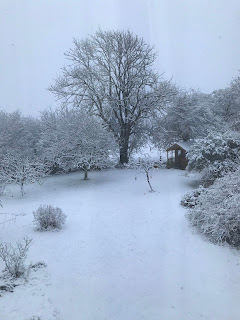Even a quiet Covid Christmas inevitably leads to a lot of
advance shopping and preparation. Why,
when the shops are open again on Sunday?
I suppose we just follow what we’ve always done. As a result, there’s so much to do and so
little time to get it done. Hugh Johnson
appropriately called it the Season of the Great Too Much, and even with only
two of us in the house it’s not so much No Room at the Inn as No Room in the
Fridge. Until Christmas Eve it was also No
Room yet Decorated with Greenery, because of other things needing to be done,
and because it had been too wet in the preceding days to bring in dry(ish)
material to deck the halls with.
We’ve never got into the habit of having a Christmas tree;
instead I decorate the banisters and at least one mantlepiece with greenery, of
which there’s plenty in the garden. This
year, having instituted a local online competition for various Christmassy
things (best-dressed Christmas tree, homemade door wreath, table decoration etc),
I thought I ought to show willing and create my own Christmas wreath.
 |
| Mossing the wreath |
It’s a complete DIY wreath.
The only non-natural element is an old wire coathanger which I’ve used
to form the initial ring (and to provide a hanging hook). First step was to bend it into a rough circle
(more of a diamond really, but that doesn’t matter too much). Then I used several long, thin, whippy stems
of Buddleja alternifolia (which needs cutting back anyway) to build up the
wreath, twisting them around the wire; a few of the thicker ends stuck out, but
I reckoned (rightly) that I could work them in during the subsequent
stages. This produced a rather
thin-looking wreath – I could have added more buddleja but at that point it started to
rain again and I retreated indoors – but next I added the moss, which built it
up considerably.
The moss was easy to come by; there’s more than enough in
the lawn to moss up thousands of wreaths.
Ten minutes with the wire rake pulled up a big bagful, of which in fact
I only needed half; it made scarcely any inroads into clearing that patch of
lawn, but it was enough to please the local robin.
Then I spent a damp and drizzly half-hour in the greenhouse binding it
onto the wreath with green garden twine, creating something that looked quite
professional except for the slightly wonky shape!
 |
| All mossed up |
As a base material, I used bits of leylandii from the long
hedge. Just as well that I didn't complete trimming the hedge in the autumn! It made an effective covering,
but I was surprised how tricky it was to get the ends to penetrate the
moss. In my impatience I probably used
too-long pieces of leylandii, resulting in them sticking out rather than
forming the smooth base that I was aiming for, but it looked not too bad. I intended to use yew on top to create a
slightly more elegant finish, but, having added a few yew twigs, I realised
that its habit of growth is rather splayed and spiky and it creates too jagged a profile,
and anyway it could hardly be seen against the leylandii, so I didn't bother adding more. You have to look closely to see the yew at
all!
 |
| Leylandii (and spot the yew if you can ....) |
This dark base then needed some decoration. Last week we saw a wonderful wreath on a door
in Cirencester, decorated largely with brussels sprouts (some would say that it’s
the best use for sprouts), looking really good. I do have sprouts in the garden, but they’re
tiny – not much use either for eating or for decorating wreaths. So, for a highlight, I cut a few sprigs of
the variegated euonymus that was a present back in the summer, and which has
settled in extremely well, to the extent of now needing some trimming to
shape, so it was two jobs in one. It looks not unlike variegated
holly, which is quite appropriate for a Christmas wreath.
 |
| With euonymus.... |
Then some orange seed-pods of Iris
foetidissima for additional decoration.
 |
| ... and iris seed-pods |
The end result looks a little like it’s having a bad hair
day, but it does the job! It’s now
hanging on the front gate, wishing passers-by a happy Christmas.








